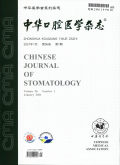血管化腓骨肌瓣下颌骨重建中髁突不同处理方法对颞下颌关节功能的影响评价
Evaluation of patients' temporomandibular joint function after mandible reconstruction with free fibula flap
摘要目的 对髁突采用不同处理方法的血管化腓骨肌瓣下颌骨缺损重建后评价患者的临床及颞下颌关节(TMJ)功能状态.方法 患者41例,其中男性21例,女性20例.41例均为累及下颌升支上部且未超过下颌中线的颌骨良性病损,其中应用腓骨替代髁突法重建24例、游离髁突法重建5例、保留髁突法重建12例.采用Fricton TMJ功能量表评价患者术后的TMJ功能,并进行统计学分析.结果 所有患者均未发生关节强直,术后最大开口度31~53 mm,平均值(42.8±5.7)mm.不同术式患者术后面部外形、进食及语音功能比较,差异无统计学意义(P>0.05);但患者的TMJ功能指数,即功能障碍指数(dysfunction index,DI)及功能紊乱指数(cramiomandibular index,CMI)间比较,差异有统计学意义(P<0.01).保留髁突组患者的TMJ功能优于腓骨替代髁突组.结论 保留髁突的血管化腓骨瓣下颌骨重建有助于恢复TMJ功能;以腓骨瓣末端替代髁突进行下颌骨重建时,重建髁突的位置和形态对于TMJ的功能有明显影响.
更多相关知识
abstractsObjective To evaluate the temporomandibular joint(TMJ) function after mandible reconstruction with free fibula flap and with different condyle treatment.Methods Forty-one cases of mandible and condyle defects following benign tumor resection were reconstructed with fibula free flap,with the condyle being reconstructed by three methods:placement of the distal end of the fibula flap into the glenoid fossa, the fibula serving as the condyle(24 cases);attachment of the resected condyle as a nonvascularized transplant to the end of the fibula flap(5 cases);condyle preservation plus vascularized fibular reconstruction(12 cases). The postoperative TMJ function was evaluated by Fricton function index.Results No TMJ ankylosis occurred in all patients. There were no significant differences in aesthetics,deglutition and speech function among the three groups;but there were significant differences in TMJ function index(DI,CMI)among different condyle treatments. Condylar preservation showed better TMJ function than fibula used as a substitute for condyle. Conclusions Preservation of condyle during free fibula mandiblular reconstruction can improve patients' TMJ function. The location and shape of fibular condyle were important factors that could influence the outcome the condyle reconstruction.
More相关知识
- 浏览366
- 被引5
- 下载56


相似文献
- 中文期刊
- 外文期刊
- 学位论文
- 会议论文



 换一批
换一批 换一批
换一批



